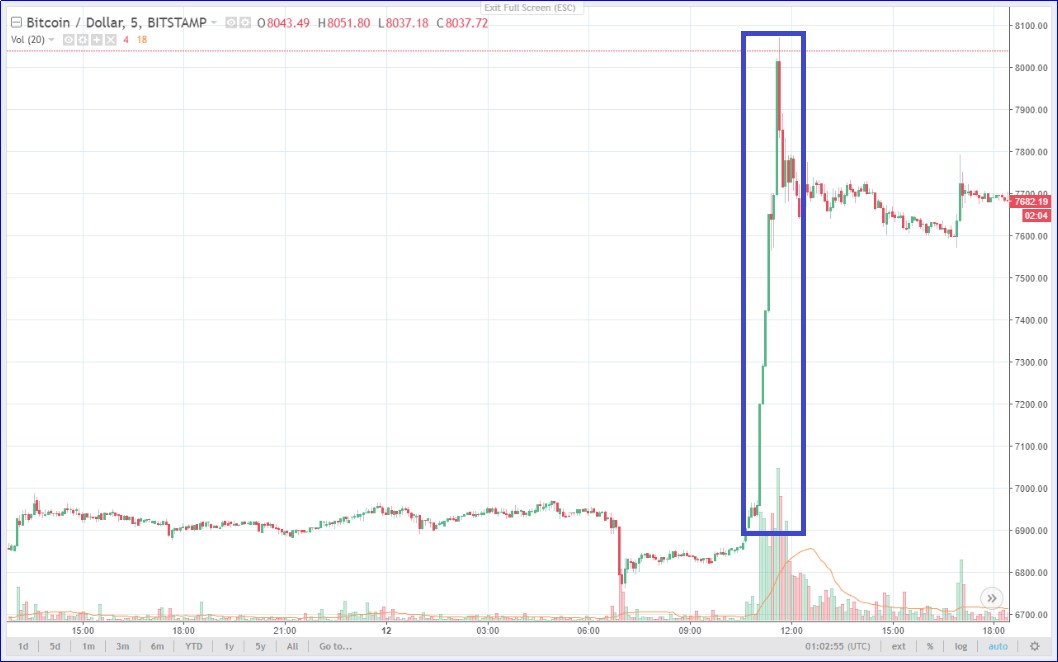Cryptocurrency margin trading allows traders to amplify their potential profits (and losses) by borrowing funds. This guide will explore margin trading, particularly on Bitfinex, and consider why traders might (or might not) choose it over other exchanges. We’ll delve into derivatives, potential market manipulation claims, and what beginners need to know.
On April 12th, Bitcoin experienced a rapid price surge, climbing over 16% (or $1100) in just 45 minutes. Major cryptocurrency derivatives exchanges like Bitmex saw significant trading volume during this period. However, some within the cryptocurrency community suggest that exchanges might be involved in manipulation and stop-loss/liquidation hunting. Let’s examine margin trading and evaluate these claims.
Understanding Margin Trading and Derivatives
The growth of the cryptocurrency market has fueled the popularity of derivatives, and cryptocurrency exchanges are eager to provide margin trading services.
Derivatives: A derivative is a financial instrument whose value is derived from an underlying asset, in this case, a cryptocurrency.
Cryptocurrency exchanges are competing to offer margin trading services, enabling users to borrow funds for trading. This allows them to potentially increase profits (or losses) before repaying the loan. Margin trading involves leverage, which increases your trading power through borrowing.
Leverage lets you control a larger position than your capital would normally allow. It’s expressed as a ratio; for example, 3:1 leverage means you can hold a position three times the value of your trading account. So, if you have $10,000, you could trade up to $30,000 worth of cryptocurrencies.
Traders use these services for various trading strategies like scalping and swing trading. Margin trading also enables shorting, where you sell cryptocurrencies with the expectation of buying them back at a lower price to profit from a market decline.
There are two main types of margin trading markets:
1. Spot Markets
In a spot market, the assets being traded are borrowed from a lender and repaid (with interest) upon closing the trade. Bitfinex, for example, uses a peer-to-peer lending system where other platform users provide the loan.
The exchange ensures loan repayment, so positions have a liquidation threshold. If the asset’s value moves significantly against the trader, they might not have enough funds to repay the loan. This is why there’s an initial margin level and a maintenance margin level.
- The initial margin limit (30% on Bitfinex) prevents traders from taking excessively large positions.
- The maintenance margin limit (15% on Bitfinex) is the point where the exchange issues a margin call (forcefully closing the position) to prevent a negative balance.
For instance, with 3x leverage on Bitcoin/USD, your initial margin is 33%. If Bitcoin drops 18% (33% – 15%), you’ll receive a margin call, and the exchange will close your position to limit losses. When a position is margin called, it’s traded on the regular market to close it. If you’re long on Bitcoin/USD, the position is sold to get USD to repay the loan. The exchange isn’t taking your position; it’s forcing you to close it in the market to repay the lender.
2. Derivatives Markets
Derivatives markets, like Bitmex, function differently. The underlying asset isn’t exchanged when establishing a position. Instead, traders take opposing sides of a futures contract. Derivatives are useful because you only need a fraction of the contract’s equity, rather than borrowing the asset.
Initial and maintenance margin rules still apply, but instead of repaying a P2P loan, it’s to protect the exchange from negative balances. If an account went negative, the exchange couldn’t recover the difference. Therefore, they need a mechanism to prevent excessive losses.
Bitmex differs from Bitfinex because Bitmex takes on the position during a margin call. This is part of their “liquidation engine,” which closes the position in the market. The position’s maintenance balance offsets the liquidation engine’s loss. Any profit/loss is added to the “insurance fund.”
Bitmex uses this system because of the high leverage they offer. Losing trades could easily result in a negative balance. The insurance fund covers these negative balances. The insurance fund isn’t a conspiracy to steal money; it’s necessary because margin calling can’t always close positions in time during large market swings. It provides a mechanism to avoid negative balances.
Short Squeeze & Margin Cascade
Looking back at the chart of the Bitcoin price spike on April 12th, the red line represents Bitfinex margin shorts, and the green line represents margin longs. Before the surge to $8069, margin shorts were at record highs. As the price rose sharply, these shorts were rapidly liquidated.
As the initial shorts were liquidated, they were forced to buy into the market, pushing the price higher. This triggered further liquidations, forcing more buying, and further price increases. This cascading effect caused the price to skyrocket as positions were forcefully closed. Margin shorts decreased significantly within an hour.
This phenomenon is known as a short squeeze.
Short Squeeze: A short squeeze happens when a heavily shorted asset’s price increases rapidly, forcing short sellers to cover their positions, thus adding even more upward pressure on the price.
The short squeeze was a risk many traders overlooked. Short squeezes are a reality that traders must be aware of when trading any asset.
Crypto Exchange Manipulation & Conspiracies
Some claim that exchanges manipulate stop-losses to “extract a higher market fee” from liquidated traders. However, each trade involves a market maker and a market taker. The exchange earns the same fee per volume regardless, assuming no tiered fee structure, because one side always pays the taker fee.
Market Makers: Those who create limit orders.
Market Takers: Those who fill orders from the order book, by buying/selling directly to limit orders.
Maker fees: Fees paid when you add liquidity to the order book by placing a limit order.
Taker Fees: Fees paid when you remove liquidity from our order book by placing any order that is executed against an order of the order book.
While exchanges have an incentive to increase trading volume through margin calls, it’s a roundabout way to extract relatively small value while potentially alienating clients. Exchanges would likely focus on other revenue streams, such as new services and trading pairs, before resorting to large-scale market manipulation. Exchanges are platforms that facilitate trading between different parties, not market makers themselves.
Stop-loss/margin hunting likely occurs to some extent, but exchanges themselves probably don’t gain much from it. Instead, institutions or “whales” may profit by accumulating a position at a lower price and then triggering a short squeeze to sell into the margin cascade. This requires building up exposure before manipulating the market.
While it’s possible that exchange operators engage in stop-loss hunting separately, the exchange itself and its liquidation mechanisms don’t profit significantly from such actions and risk losing customers. The financial incentives don’t align for the exchange’s direct involvement.
Why Bitfinex? Why Not Other Exchanges?
Bitfinex offers a relatively transparent P2P lending system for margin trading. This can be attractive to users who prefer to see the source of their borrowed funds. However, Bitfinex has faced controversy in the past, which may make some traders hesitant. Other exchanges like Binance, Kraken, and Bybit offer margin trading with varying features, leverage levels, and risk management tools. The best exchange for you depends on your individual trading style, risk tolerance, and research into the platform’s security and reputation.
Conclusion
Margin trading can be a powerful tool, but it’s crucial to understand the risks involved, including the potential for short squeezes and margin cascades. Whether you choose Bitfinex or another exchange, thoroughly research the platform and develop a solid risk management strategy before engaging in margin trading. Remember, leverage amplifies both profits and losses. Consider beginning with paper trading to test your strategies and acclimate yourself to the platform before risking real capital.

